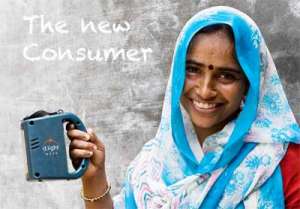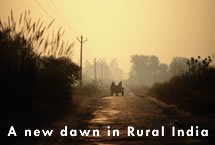I still remember the time when after a long, laborious journey to my village, the only option I had to quench my thirst in the nearby kirana shop was Coke or Pepsi. My mom wanted Real Juice but had to compromise on her choice while sipping the 200ml tetra pack of Frooti. Coming from the market prism of the urban world, did make me cringe over the compromises I had to make in my rural residence. The lack of choices and restrictive buying options in the rural markets of India made one wonder the increasing need of the development of retail sectors in rural India and thus came the much awaited BOOM! My latest visit to my much modified village proved that Yes, the Boom came and came with a Bang.
Marketers scratched their creative brain-houses and toiled day and night to come up with a plethora of solutions and decorated the basket of ideas to present it to our dear rural counterparts because they, in words of CK Prahalad, do realise that large viable markets exists at the bottom of the Pyramid.
In India ,the rural and semi urban areas takes the load of about 70 % of the population and In recent years, rural market of India have acquired high significance, as the purchasing power of the rural communities has increased considerably with the overall growth of the Indian economy. The growth of rural market has been estimated at around five times the rate at which urban markets are growing, thereby offering generous opportunities to marketers.
The Unprecedented Rise of the Rural Customer
The untapped rural markets act as an open ocean for the big time retailers by providing  opportunities for exponential growth. While the retailers at this moment are running away from the sluggish and almost drenched urban market, the rural market comes as a breath of fresh air with 830 million consumers with increasing cash in their pockets and unsatisfied demands.
opportunities for exponential growth. While the retailers at this moment are running away from the sluggish and almost drenched urban market, the rural market comes as a breath of fresh air with 830 million consumers with increasing cash in their pockets and unsatisfied demands.
The factors’ holding the strings of the wallet together for the rural buyers mainly comprises:
PAISA Principle: The rural retail face has enhanced with the increment in the buying power of the people. The ambitious Rural Yuppie (males in 15-34 age group) moves out for superior jobs send the money home. This in turn, has increased the disposable income and led to a surge in the demand of consumer goods. The monthly per capita expenditure (MPCE) grew by around 350% in the last two decades. The sharp ascend in the minimum support price of wheat and paddy brought in the riches with themselves. The agricultural loan waivers worth Rs. 60 thousand crores and various other development schemes such as National Rural employment Act and Bharat Nirman Programme have contributed in increasing the income as well as the consumption level of the rural people’s substantially.
Learning beyond Ka, Kha, Ga: The reluctance in accepting the conventional form of education has seen the decline in rural India, with a gap of 15 points between the literacy rate of urban and rural India, Literacy rate in rural areas was pegged at 71 per cent compared to 86 per cent in urban areas, according to NSSO survey released in June’ 2015.
 The demand for knowledge enhancement tools has increased positively and the increase in socio-economic status of rural people has encouraged the retailers to promote educational goods and items. Also, the government initiatives such as Digital India Programme and Skill India will provide impetus to this growth.
The demand for knowledge enhancement tools has increased positively and the increase in socio-economic status of rural people has encouraged the retailers to promote educational goods and items. Also, the government initiatives such as Digital India Programme and Skill India will provide impetus to this growth.
Opportunities Galore
The last five years have seen the rural infrastructure grow like never before. The penetration of telecom sector in the untreaded paths of India has increased seven fold and the tele-density has seen a rapid increase in the last few years.
 Also, more than half of India’s villages are now connected to all weather roads which has led to the improvement in the distribution system and has hence made the brands more readily available. The companies have also realized that the major chunk of sales is skewed towards some villages which is clearly understandable from the fact that last year 72% of the total FMCG sales were contributed by just 10 states.
Also, more than half of India’s villages are now connected to all weather roads which has led to the improvement in the distribution system and has hence made the brands more readily available. The companies have also realized that the major chunk of sales is skewed towards some villages which is clearly understandable from the fact that last year 72% of the total FMCG sales were contributed by just 10 states.
- According to a report by Mckinsey Global Institute the rural market is forecasted to create a vast potential of $577bn by the year 2025 hence nearly tripling the current number
- Consumption growth rate in rural India is pegged to be at 5.1% during the next decade
- Introduction of financial inclusion schemes by the incumbent government will not only help in increasing the spending capacity of the rural India but also provide financial literacy that would allow the customers take intelligent purchase decisions
- According to recent Nielsen estimates, $12 billion FMCG market in rural India is expected to hit $100 billion by 2025
- The average consumption in the hinterland is growing at 1.5 times the rate in developed urban areas
Driving the Cart of Change with the Fuel of Ideas
In a bazaar where life has revolved around deep rooted community values, well-knit clusters of joint families, and unquestioned social customs & taboos, marketers realize that the conventional routes of market ingress and brand building as was employed in urban India are often not feasible with the rural customers.

The likes of Coca-Cola have always tried to gain the first mover advantage and in this aspect they have started various programmes like Parivartan, which are aimed at teaching the rural retailers basics of inventory management merchandizing. Coca-Cola has installed customized buses which travel through the untapped markets across India to reach the various upcoming retailers in the form of mom-and-pop stores. Also, in order to fight the lack of continuous power supply in these highly lucrative rural markets, Coca-Cola has provided its retailers with logo branded solar powered coolers to keep the drinks cold. This has led to increase in the sales by more than four times.A study which was conducted on buying behaviour of rural consumer’s points to the fact that the purchase decisions in the rural market are highly influenced by the retailers and this figure goes as high as 35%. Hence there stood a need for the companies to build a healthy and fulfilling relationship with the rural retailer who can help them understand the psyche of the rural customer in a better way and also appreciate the difference in opinions which arise due to heterogeneity in the structure.
ITC’s Chaupal Sagar was one of the first organized retail initiatives into the rural market. This business model was a result of 3 years of extensive research and an investment of more than Rs. 80 crores. ITC has gone further and realized the exponential growth rate of mobile penetration in rural India by helping the retailers use mobile technology in the ordering of appropriate amount of stock to avoid higher levels of inventories with retailers, hence reducing their variable costs.
The rural retail hubs have also been on the ascend by the mode of “Hariyali Kisan Bazaar” by DCM Sriram Consolidated Ltd., and another by a joint venture of Pantaloon and Godrej titled Aadhar. Kisan Sansar by Tata, Reliance Fresh and Nava Yug Bazaar are also establishing their outlets at strategic locations.
Revolutionary marketing campaigns such as Kan Khajura by HUL are changing the dynamics for brands by raising the bar continuously and also driving sales for their already setup distribution channel.
Conclusion
Rural Indian consumers have a diverse set of requirements that should be met by the combined effect of both package and product. The need was to chalk out a proper time oriented plan which includes devoting time to research and analysis of the rural Indian consumer as well as the market before we plan to dive in, this has helped to avert redundant struggles and failures. If the prospect exists, partnering with an accessible Indian company upon market entry can offer several key advantages to a company. Getting to know the blood in the veins of the rural consumers by understanding the present distribution networks in rural India is decisive in making a triumphant entry into the rural Indian market. Distribution abuse due to poor roads and more primitive modes of transportation ought to be avoided by designing the packages that can withstand the hardships. Finally, when creating a package for rural India, small sizes allow consumers to try new and varied products. Retailers are fast penetrating rural India because of which Rural India is experiencing the identical changes as urban India – altering consumer preferences and consumption patterns, escalating exposure to different lifestyles and products, and mounting purchasing power. Thus the anticipation of what will come next, and how the face of rural India changes with more and more innovative heads entering the bazaar, we wait crouching at the end of our seats to witness the eventual spectacle after the BOOM.
Tags: retail Rural MarketYou might like reading:

Xiaomi in India- The strategy behind its success
Xiaomi is the newest company to enter the highly competitive mobile device market in India. But does the staggering response on its Flipkart sale and a positive view by Indians indicate a conclusive future for the company in India? Or will the high demand and less supply prove to be redundant for the company? Xiaomi is rather unknown among […]
XIMB Hosts Corporate Sports Meet “Colosseum 2015”
On 26th and 27th September 2015, XIMB hosted “Colosseum 2015”, the first of its kind sports event including the corporate houses of Bhubaneswar. The event was a celebration of the enduring relationship XIMB shares with the corporate houses and marks the beginning of “Athlos2015”, the annual inter B-School Sports Meet of XIMB, to be held this October.Infosys Limited and Tech […]






























